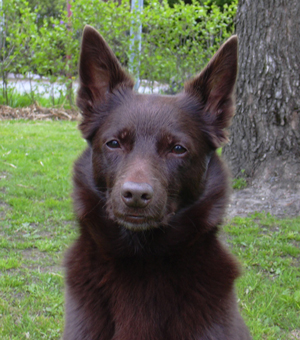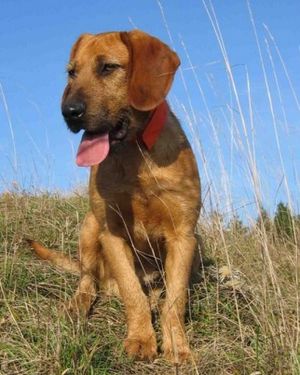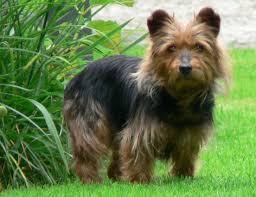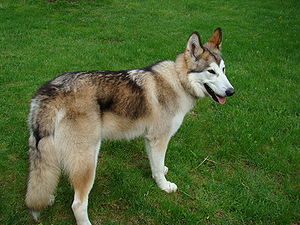 |
| Vital Statistics: |
| Place of Origin: Australia |
| Group: Herding |
| Height: 17-20 in. |
| Weight: 25-45 lbs. |
| Life span: 14 yrs. |
| Trainability: high |
| Good with children: yes with early socialization |
| Good with other pets: may try herding other animals |
May’s Dog of the Month
Foxlike in appearance, the Kelpie is a very intelligent, high energy herding dog, easily trained.
What is the origin of the Australian Kelpie?
Legend tells that the Kelpie claims as its ancestors, the Border Collie and the Dingo. But documentation has shown the Kelpie to have developed from English North Country Collies. In the last half of the 19th century, they were brought to Australia to herd livestock. The breed has been known since 1870.
What does the Australian Kelpie look like?
The Kelpie is fox-like in appearance, 17-20 inches tall and 25-45 lbs. Ears are erect. The coat is thick and short. Colors are black, black and chestnut, red, red with chestnut, tan, dark chestnut or blue-grey. Regular brushing is necessary as the Kelpie can shed quite a bit.
What is the Australian Kelpie’s temperament?
The Kelpie is quite intelligent. It is easily trained, obedient and works enthusiastically and tirelessly. Independent thinkers and sometimes displaying dominance traits, they need firm, early training and socialization.They are high energy dogs, always on the move. These dogs need an owner willing to give them lots of vigorous exercise. Used to the wide open spaces and due to their limitless energy, Kelpies don’t do well in apartments. They herd by nipping at the heels of livestock and my do the same instinctively to children and adults as well.
What are the uses of the Australian Kelpie?
The Kelpie is an excellent herding dog. It is very fast and responds quickly to signals, whether spoken or given by hand. The Kelpie works very well in obedience and agility trials.
Possible Health Issues
Hip dysplasia, progressive retinal atrophy (PRA), cataracts, collie eye anomaly, coloboma (missing part of the eye’s iris, discomfort in bright light), rarely cerebellar ataxia
- Australian Cattle Dog
- Australian Shepherd
- Bearded Collie
- Beauceron
- Belgian Sheepdog – Groenendael
- Belgian Tervuren
- Bergamasco
- Berger Picard
- Blue Lacy
- Border Collie
- Bouvier des Flandres
- Briard
- Cardigan Welsh Corgi
- Catahoula Leopard Dog
- Collie
- English Shepherd
- Entlebucher
- Finnish Lapphund
- German Shepherd
- Hovawart
- Icelandic Sheepdog
- Laika
- Lancashire Heeler
- Miniature American Shepherd
- Mudi
- Old English Sheepdog
- Pembroke Welsh Corgi
- Polish Lowland Sheepdog
- Puli
- Pumi
- Pyrenean Shepherd
- Shetland Sheepdog
- Standard Schnauzer
- Swedish Vallhund



